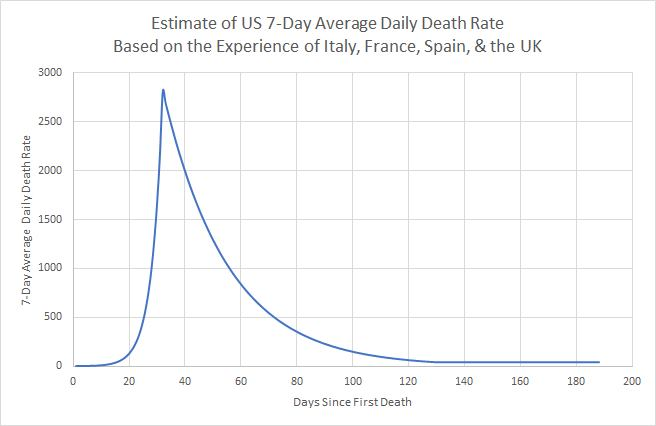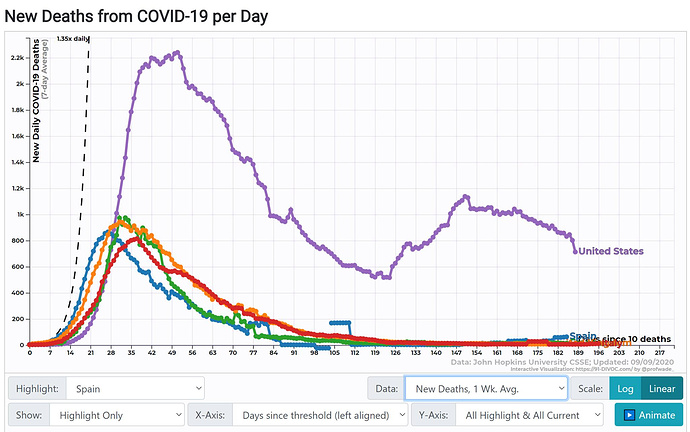Steven Millman update:
September 10th COVID Update Hypothetical: How many Americans would have died of COVID-19 by now had we followed the path of European national responses?
SHORT VERSION: 77,305 meaning we have seen more than 113,000 unnecessary deaths SO FAR with more every day. Take this estimate with a grain of salt, because error margins are wide, but there’s no doubt the death toll could have been far lower than the current 190,000.
tl;dr as though I even need to say that anymore
Given the news of the day, a question I’ve not been generally interested in answering has come up so often that I’ve finally decided to run it. That question is, How many Americans would have died of COVID-19 by now had the government and the population reacted to the pandemic in much the same way as other developed nations which were initially hit hard? This is pure conjecture, and please take it as such. I’ll do my best to spell out the assumptions clearly.
To make a reasonable comparison, I’ve modeled the answer to this question based on countries which (1) took a heavy toll before reacting effectively, (3) eventually reacted effectively – looking at YOU Sweden, (3) are Western democracies with well-developed individual freedom, and (4) have modern medical care systems. For this thought experiment, I therefore selected Spain, France, Italy, and the United Kingdom. These four countries managed to get the virus under control (more or less) after disastrous early death tolls.
On average, these countries reached their peak death rate as defined by their highest seven day average in about 32 days from the date of the first death (range: 27-37) at which point they were averaging 886 deaths per day (range: 760-975). After this sharp increase, deaths began to decline quickly, albeit at a slower rate than they rose. On average, these countries dropped to ½ of their peak death rate on 22 days later on day 54 (range: 16-27), to ¼ of their peak 18 days after on day 72 that (range 12-22) and reached an equilibrium state of just under 10 deaths per day (range 2.5-19) on about day 130.
To build a more or less similar curve, I assumed that had we responded like our European counterparts we would also have peaked on day 32 and used our actual death count on that date as the starting point for the models. I then assumed we would have dropped to ½ of that rate on day 54, ¼ of that rate on day 72, and reached equilibrium on day 130. Because of the simplicity of this approach the attached figure has a sharp peak rather than a rounded one, but it effects the estimated death count with only marginally. The attached images show the US actual 7-day average death rates as well as Italy, Spain, France and the UK along side the simplistic model of the US death rates following European models. The best fit model created an asymptote (leveling off) at about 40 deaths per day in the US. That’s much higher than the other countries, but then again, the US is a much larger country as well.
The current death toll from COVID-19 today – day 189 – in the US based on Johns Hopkins data is 190,862. The total death estimated death toll for the US on day 189 based on the European model is 77,305. Based on these assumptions, the US has allowed itself 113,557 unnecessary deaths SO FAR.
Making matters worse, we are currently averaging about 1,000 deaths each day in the US, not 40. This means that the number of unnecessary deaths is increasing by almost 1,000 Americans each and every day. My current published model for the US has us reaching equilibrium at 574 deaths per day, so when we do eventually level off (before rising again in all likelihood) we will be adding 534 unnecessary deaths per day.
REMEMBER: There are a LOT of assumptions in here to generate a best fit model estimate for the US based on the experiences in Europe. I don’t have tons of faith in the EXACT 77,305 estimate and neither should you. It is, however, quite reasonable to believe based on the data that the real unknowable answer to this hypothetical is between 50,000 and 100,000 deaths had we reacted more forcefully as a nation. No matter how you slice it, it’s a LOT lower than the results of our half-hearted and occasionally outright oppositional response to the pandemic.
So how do we get out of this literal and figurative death spiral? Simple. Do the things you already know you need to do. Avoid crowds, especially indoors. Wear a mask when around others and wash your hands frequently. Social distance. As I’ve said many, many times, we have never been much more than one month from getting the virus under control and having our normal(ish) lives back if we all collectively did these things. We can do it – all of our peers have. Please?
I understand the news of the day and that virtually everyone reading this will want to toss political blame, but honestly, I don’t find that particularly helpful. Just follow the science, encourage people to do the same. It makes no difference at this point which political tribe you follow, just do the obvious stuff and then we can get back to gleefully arguing about regular things like tax cuts, budget deficits, and judicial appointments. That sounds a lot better to me than doing these damnably depressing models.
Data are drawn from Johns Hopkins University’s COVID tracking project. As always, don’t forget I’m not a medical professional or epidemiologist. I’m a professional statistician with too much on my mind.

